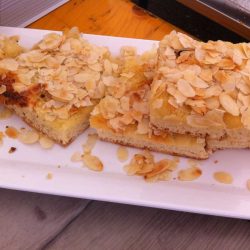In the realm of pastries, few treats can rival the irresistible charm of Butterkuchen, a delectable delight that has captivated taste buds for centuries. Its name, aptly translating to “butter cake,” perfectly encapsulates its essence – a golden, buttery crust cradling a soft, custard-like center, studded with sweet, caramelized almonds. Its simplicity belies its rich history and versatility, making it a timeless favorite among bakers and pastry enthusiasts alike.
A Journey through Butterkuchen’s History
The origins of this delicious pastry can be traced back to medieval Germany, where it was a staple in many households. Its popularity soared during the 17th century, when bakers began experimenting with different variations, incorporating ingredients like raisins, apples, and cinnamon.
Over time, it became a symbol of German hospitality and warmth, gracing countless tables during festive gatherings and family celebrations.
Butterkuchen: A Culinary Canvas for Creativity
The beauty of Butterkuchen lies in its simplicity, allowing bakers to personalize it with their unique touches. While the traditional recipe calls for a basic yeast dough, some prefer to use a flaky puff pastry or even a shortbread base. The filling, typically a custard-like batter, can be enriched with eggs, vanilla extract, and a hint of lemon zest.
Almonds, the quintessential Butterkuchen topping, add a delightful crunch and nutty flavor. Sliced almonds are traditionally scattered over the custard before baking, but some bakers prefer to grind them into the batter for a more intense almond flavor.
Unveiling the Secrets of Butterkuchen Baking
The process of baking Butterkuchen is akin to a culinary symphony, requiring a harmonious balance of ingredients and technique. The dough, whether yeast-based or pastry, needs to be carefully rolled out to the desired thickness. The filling, a delicate balance of eggs, milk, and sugar, is gently poured over the dough, ensuring even distribution. Finally, the crowning glory – almonds – are meticulously arranged over the custard, ready to transform into a symphony of textures.
The baking process itself is a mesmerizing spectacle, as the Butterkuchen undergoes a magical transformation. The dough puffs up, releasing the warm aroma of butter and almonds. The custard thickens, taking on a golden hue. And the almonds, once pale and unassuming, caramelize into crunchy, sweet gems.
A Culinary Delight for All Occasions
Butterkuchen’s versatility makes it a culinary chameleon, effortlessly adapting to various occasions. Whether served warm with a dusting of powdered sugar for a cozy breakfast, paired with a dollop of whipped cream for an elegant dessert, or enjoyed as a simple afternoon snack, Butterkuchen never fails to delight.

Butterkuchen Recipe
Ingredients
- 500 grams 4 cups all-purpose flour
- 10 grams 2 1/4 teaspoons instant yeast
- 50 grams 1/4 cup granulated sugar
- 300 ml 1 1/4 cups lukewarm milk
- 1/2 teaspoon almond extract
- 1 teaspoon vanilla extract
- 1 large egg at room temperature
- 1/2 teaspoon salt
Topping:
- 125 grams 1/2 cup cold butter, cut into 1/4-inch cubes
- 100 grams 1/2 cup granulated sugar
Instructions
- In a large stand mixer bowl, whisk together the flour, yeast, and sugar.
- Add the lukewarm milk, egg, salt, and extracts to the bowl. Using the dough hook attachment, knead the dough on low speed for 10-15 minutes, or until it is smooth and elastic.
- Place the dough in a lightly greased bowl, cover it with plastic wrap, and let it rise in a warm place for 45 minutes to 1 hour, or until it has doubled in size.
- Preheat the oven to 350 degrees F (175 degrees C). Line a baking sheet with parchment paper or a silicone baking mat.
- After the dough has doubled in size, punch it down to release the air. Gently stretch and press the dough out from the center until it reaches the edges of the pan. Cover the pan and let the dough rest for 10 more minutes.
- While the dough rests, cut the cold butter into 1/4-inch cubes.
- After 10 minutes, dimple the dough about every 3/4 inch with the handle of a wooden spoon. Press the cubes of butter into the dimples.
- Sprinkle the sugar over the top of the cake, making sure to cover the edges.
- Let the assembled dough rest for 10 more minutes.
- Bake for 30 minutes on the middle rack, rotating the pan after 15 minutes so that it bakes evenly.
- Remove from the oven and let cool on a wire rack before slicing.
Notes
- For best results, use room temperature ingredients.
- If the dough is too sticky, add a little more flour. If it is too dry, add a little more milk.
- The dough should be soft and elastic, but not sticky.
- Let the dough rise in a warm place, free from drafts.
- Do not overbake the cake. It should be golden brown and springy to the touch.
- Let the cake cool completely before slicing.
FAQ:
What is the difference between Butterkuchen and other German pastries like Strudel and Apfelkuchen?
Butterkuchen is distinguished by its simple, yet rich, custard filling and signature almond topping. Strudel, on the other hand, features a thin, flaky dough layered with apples and spices, while Apfelkuchen showcases a lattice crust atop a generous apple filling.
Can I substitute almonds for other nuts or dried fruits?
While almonds are the traditional topping, you can certainly experiment with other ingredients. Chopped hazelnuts, pecans, or walnuts add a delightful crunch, while dried cranberries or apricots provide a burst of tartness.
How can I store Butterkuchen to maintain its freshness?
Freshly baked Butterkuchen is best enjoyed at room temperature. For longer storage, wrap it tightly in plastic wrap or aluminum foil and place it in the refrigerator for up to three days. Reheat it gently in a low oven to recapture its warm, buttery goodness.
Conclusion:
Butterkuchen, a simple yet iconic German pastry, captures hearts with its rich history and irresistible taste. This timeless favorite, crafted from basic ingredients, welcomes experimentation and diverse variations. Indulge in its golden-brown crust, buttery richness, and perfect sweetness. Embrace your Butterkuchen adventure, exploring its charm and savoring its delightful flavors.
Don’t miss out on trying our amazing vanilla cupcakes recipe, offering a delightful simplicity that complements any baking journey.






